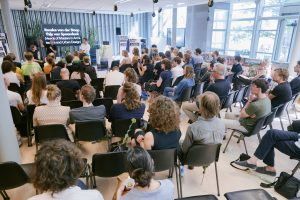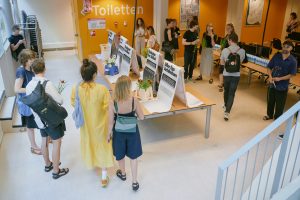RADICAL SUFFICIENCY: is this it?
3 juli 2023Architectual Designer Edgars Jane wrote a summary on the work conference “No More Building as Usual: Architecture Beyond Carbon and Greed”.
Saturday june 24th, there was a day-long conference at the Rotterdam Academy of Architecture structured around the critical reflection on the position of architects in times of extreme material consciousness. . Under the headline “No More Building as Usual: Architecture Beyond Carbon and Greed” specialists from various fields were discussing and imagining directly implementable tactics to accelerate the minimisation of carbon production associated with the building processes. The big question that lingered in the air was: who actually is the real client today?
The day was split into a two-part programme. In the morning a number of parallel breakout sessions took place, centred around reflections on the current role of an architect. Shortly after the afternoon session with keynote speakers took place, who shared their own takes on the topic of the conference.
Here are some interesting takeaways from the speakers:
Winne van Woerden, (Commons Network) talked about #degrowth as a framework to redefine social progress beyond growth, and a way how to step outside of the “capitalist individualist mentality”. She invited her audience to think about “what kind of future & societal values do we want to promote?” Which society are we designing for? The society of today or tomorrow? “As the society in 25 years will be completely different, shouldn’t we be designing for them and not for the ones now?”
Winne urged her audience to “link efficiency to sufficiency”. This felt like the most crucial point of her talk. By asking whether our practices “provide for needs, or wants?” she called for an emergence of a “culture of sufficiency”. In essence, proposing to focus on intergenerational value. Instead of designing for energy efficiency to rather aim for climate neutrality.
Maarten Gielen shared some radical insights from his years at Rotor vzw-asbl in Brussels. In a friendly opposition, he asks: “if it takes 30 years to decide what should be cancelled – SUV’s, private jets, or..chocolate.. then perhaps it’s too late? Maybe let’s not do it at all then?”. A sober invitation to not look for things to cancel, but persistently keep minimising our ecological footprint and optimising salvaging processes. He emphasizes that “we need to salvage capital” and that the time to do it is NOW! We cannot simply abolish it, we have to do it in this economy.
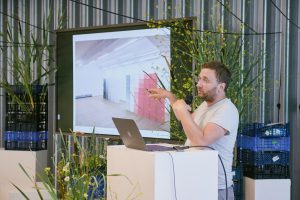
Maarten Gielen finishing his keynote with a proposal to add more ‘radical sauce’ to the field.
Is changing the system THE answer, I wonder? Adopt a non-system? Which is better? Maarten reflects that “with any system there is always someone who is in charge. And they will always be defending themselves and their position against change”, therefore pre-conditioning any system to be subject to eventual corruption. According to him, “sustainability is a-political; it is technological”. “Something that is a need—can become sustainable; if it is not a need, it needs not to be sustainable.” He finally asks, rhetorically: “what is comfort today?”.
“Human suffering doesn’t compound – ecology does. Today, planet is our first issue, humans come second.”
As someone in the audience mentions that Rotor has often been described as being a “curatorial company who simply organises materials” I cannot help but think that perhaps we also could simply begin by turning some simple action into tangible design! Wouldn’t that be enough?
Maria Lisogorskaya, representing ASSEMBLE, was the final speaker who challenged her audience to articulate their own “personal emergency—and find it!”. The idea of setting goals, rather than having grades is a recurring theme with Maria, which she clearly summarises by saying that “we should get rid of assessments and forms on goals and emergencies”. Why?
In an overly-saturated language field, she promotes an “eye level perspective”, in order to not make things too abstract. She encourages us to “explore the boundaries of our knowledge and when and who to bring in”. Simply put, to begin by realising what we are missing. It all makes total sense.
To round off this post, I would like to share some collective insights developed during our public “group therapy” which was centred around the topic of ‘Building Rituals’. The following takeaways are the result of an hour-long combined effort to reflect on the core position of an architect today.
Takeaways from the Group session with:
Estelle Barriol (Studio ACTE), Charly Blödel (Het Nieuwe Instituut), Maarten Gielen, Roxane van Hoof & Claudio Saccucci (Studio Verter), Edgars Jane (KCAP), Laura van Santen (la-di-da) hosted and facilitated by Sven Schouten
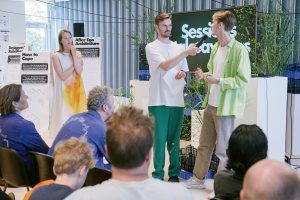
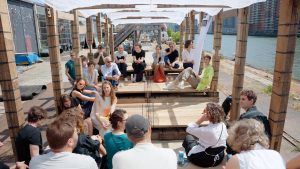
Rethinking fundamentals
“What is the need for a building today…truly? Who do we really design for? How can we question capital? In other words, who is the real client?
“How to move into the now? We need to marginally adopt the current state-of-things, and not try to create alternatives—there is no time for that. Temporarily align with the prevailing economic agenda of capital in order to radically change the direction from the inside. Everything else is too slow and too wishful.
New language
Each revolution, movement and sub-culture has used a specific language that gave it a distinct identity. Today, we should not be resistant to the professional jargon. We must embrace it as an identity with a revolutionary potential, and shape a culture through the use of this language. Coupled with an extended “knowledge of regenerative ecosystems” we, as designers, could expose circularity to be “more than a style, or a trend”. A fundamental change in the approach to architectural strategy is needed. Specifically, a development in design practice towards an approach that prioritises seasonal and material considerations over aesthetics. Put simply—design for duration. Time is the new client.
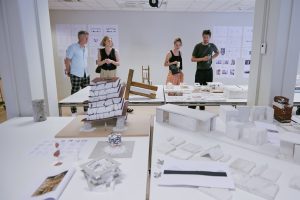
Pictures from OPEN STUDIO’S RAvB design studio “One more time with feeling”
Meet our builder and talk to those included!
One of the bigger challenges that we see dominating the following decade or so is finding a sustainable balance between living quality—individuality. In the context of an extreme global #carbondiet, undoubtedly, the process of a trade-off between the material embodied emissions & structural-thermal performance will be the prevailing ‘fight’. The word ‘trade’ does, however, imply a collaboration and a consensus, therefore we agree that as designers we must “get our hands dirty” and “meet our builder and talk to those included.” The sooner the better. Not to be naive, and instead of theorising ‘big’, embrace the small and aim for a solid incremental change. Set aims + thresholds. Be more informed and precise about the % of change you can influence as a designer.
Furthermore, I would like to personally bring up a complimentary thought from the recently debuted think-tank coalition of architectural designers, Platform Woonopgave, who ask the critical question of whether we really need to “build new, or simply find new?”
In order for us to live up to the tag-line of the conference “no more building as usual”, there is a need for a mind shift. Discontinuing to romanticise the industrial as well as abandoning all industrialised romanticism would be a serious starting point towards radical change. Instead, let us commit to keeping things simple and real. In words of T.S. Eliot, to set a goal to strive for a “condition of complete simplicity costing not less than everything”. An architecture Beyond Carbon and Greed. Radical Sufficiency.
Thank you Edgars Jane for this point of view and detailed summary.
Photography by Ruben Hamelink en Salih Kiliç
